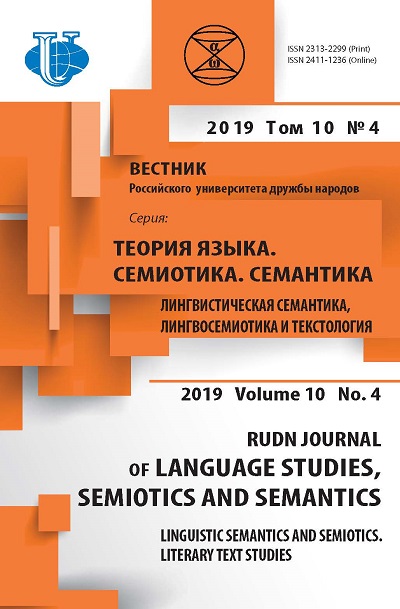Modeling of a Generalized Speech Portrait of a Blogger (as Exemplified in the German Military Blogosphere)
- Authors: Shliakhovoi D.A.1
-
Affiliations:
- Military University of the Ministry of Defense of the Russian Federation
- Issue: Vol 10, No 4 (2019): Linguistic Semantics and Semiotics. Literary Text Studies
- Pages: 879-892
- Section: FUNCTIONAL SEMANTICS
- URL: https://journals.rudn.ru/semiotics-semantics/article/view/22774
- DOI: https://doi.org/10.22363/2313-2299-2019-10-4-879-892
- ID: 22774
Cite item
Full Text
Abstract
The study investigates the modeling of a generalized speech portrait of a blog-discourse subject in the speech space of the German military blogosphere. The relevance of the work lies in the development of a methodology for modeling a speech portrait of a virtual linguistic personality, behind the mask of which is a real person, actively participating in the life of his Internet community, united by professional activities and nationality. In this work, the author uses examples from the blog discourse of the German military blogosphere, however, the method of constructing a generalized speech portrait of an online personality, based on the works of Professor Boris Boyko, we apply to the description of any linguistic personality in the communicative space of the global network. The purpose of this study is to highlight the main features for constructing a generalized speech portrait of a German military blogger as a subject of online communication. We were able to identify typical features of the speech of a German military blogger and his virtual linguistic personality, which include units of military vocabulary and terminology, jargon, professionalisms, abbreviations, stable units of verbal communication of military personnel, specific hashtags and non-verbal signs that carry concepts of duty, militancy, patriotism, mourning, etc., associated with the values of military personnel. As a result of the study, we are approaching the speech portrayal of smaller groups within the social group of German military bloggers, for example, creating a speech portrait of a military medic, paratrooper or tanky. The results of our research are of particular interest to military translators, specialists engaged in the study of the theory and practice of Internet communication, blog-discourse, social group dialectology. Knowing the specifics of the speech manifestations of certain social-group communities will allow the recognition of separate subject of online communication by speech characteristics.
About the authors
Dmitrii A. Shliakhovoi
Military University of the Ministry of Defense of the Russian Federation
Author for correspondence.
Email: magistri@mail.ru
Aspirant for a degree of Candidate of Philol. Sciences, senior faculty member, department of Germanistics
14, B. Sadovaya, Moscow, Russian Federation, 123001References
- Ryabova, M.E. (2018). Blogger’s lingual identity in modern network communication. Organizational Psycholinguistics, 1, pp. 39—53. (In Russ.).
- Karaulov, Yu.N. (2014). Russian language and linguistic personality. Moscow: Book House LIBROCOM. (In Russ.).
- Yudina, N.V. & Kuznetsova, E.A. (2016). A language portrait of a modern financier: a textbook for bachelors. Moscow: Financial university. (In Russ.).
- Boyko, B.L. (2018). Social group dialectology: monograph. Moscow: Military university. (In Russ.).
- Van Dijk, T.A. & Kintsch, W. (1988). Linked text understanding strategies. New in foreign linguistics. Publ. ХХII. Kognitive aspects of language. Moscow: Progress. (In Russ.)
- Danilevskaya, N.V. (2003). Language play. Stylistic encyclopedic dictionary of the Russian language. Moscow: FLINTA, Nauka. URL: https://rus-stylistics-dict.slovaronline.com/271-Языковая игра (accessed: 12.05.2019). (In Russ.).
- johannes.clair #Afghanistan, 2010. URL: https://www.instagram.com/p/Btc9v89hqLn/ (accessed: 15.03.2019). (In German).
- Boyko, B.L. (2008). Principles of modeling a speech portrait of a carrier of a social group dialect (on the problem of creating a speech portrait of a person in a war). Bulletin of the Military University, 2, 114—121. (In Russ.).
- Devkin, W.D. (1979). German spoken language: Syntax and vocabulary. Moscow: International Relations. (In Russ.).
- isabella.brdar. URL: https://www.instagram.com/p/BorbFiUB1fR/?utm_source=ig_web_ button_share_sheet (accessed: 17.04.2019). (In German).
- Boyko, B.L. (2008). Fundamentals of the theory of social group dialects: monograph. Moscow: Military university. (In Russ.).
- Shliakhovoy, D.A. (2017). Genre features of blogs as electronic means of mass communication. RUDN Journal of Language Studies, Semiotics and Semantics, 10(4), 939—948. doi: 10.22363/2313-2299-2017-8-4-939-948. (In Russ.).
- Kolokoltseva, T.N. (2016). Dialogues vs dialogueness. Internet communication as a new speech formation: collective monograph, T. Kolokoltseva, O. Lutovinova (eds.). Moscow: FLINTA, Nauka. (In Russ.).
- MATZINGHA, URL: http://bundeswehr-blog.blogspot.com/2013/12/15-die-spezialgrundaus bildung-beginnt.html (accessed: 17.06.2019). (In German).
- tango.delta.ger, URL: https://www.instagram.com/p/BuVmOg0HmgM5PN74EzfFvpqFnely MOXqGn-5bY0/?utm_source=ig_share_sheet&igshid=s9lhgq5lvby4 (accessed: 19.06.2019). (In German).
- bloggermuhammad, URL: https://www.instagram.com/p/BsqiIv5HbNu/?utm_source=ig_share_ sheet&igshid=wniwwvzno13r (accessed: 1.07.2019). (In German).
Supplementary files












